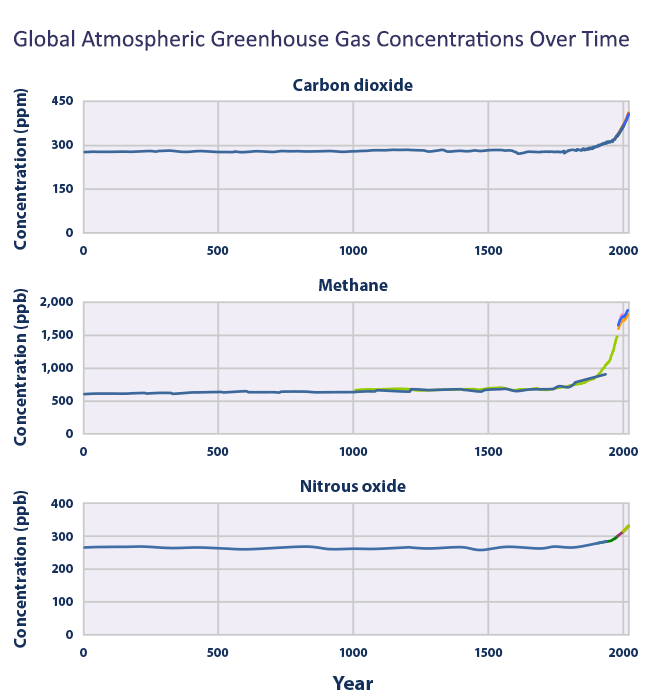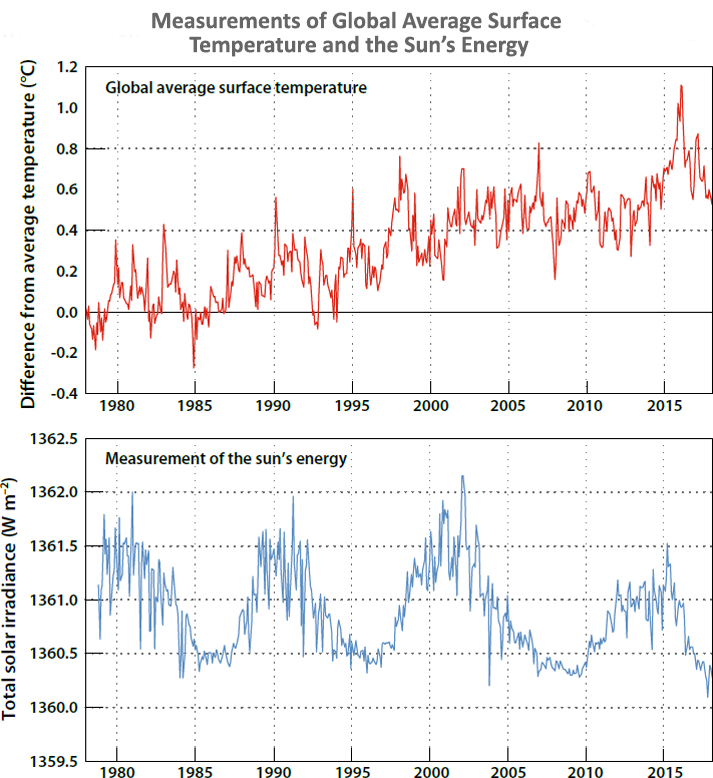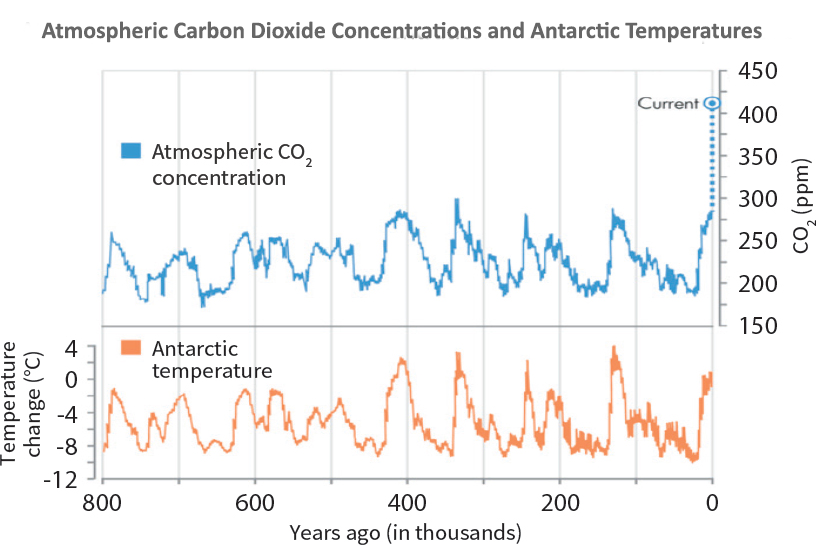How Is Human Activity Affecting Climate Change
Since the Industrial Revolution, human activities have released large amounts of carbon dioxide and other greenhouse gases into the temper, which has changed the earth'southward climate. Natural processes, such as changes in the sun's energy and volcanic eruptions, also affect the globe's climate. Notwithstanding, they practise non explain the warming that we have observed over the concluding century.1
Man Versus Natural Causes
Scientists take pieced together a record of the globe's climate by analyzing a number of indirect measures of climate, such as ice cores, tree rings, glacier lengths, pollen remains, and ocean sediments, and past studying changes in the globe's orbit around the sun.2 This record shows that the climate varies naturally over a wide range of fourth dimension scales, but this variability does not explicate the observed warming since the 1950s. Rather, it is extremely likely (> 95%) that human activities have been the dominant cause of that warming.3
Homo activities have contributed substantially to climate modify through:
- Greenhouse Gas Emissions
- Reflectivity or Absorption of the Dominicus'due south Energy
Rut-trapping Greenhouse Gases And The Earth's Climate
Source: Smithsonian National Museum of Natural History, 2018
Greenhouse Gases
Concentrations of the fundamental greenhouse gases have all increased since the Industrial Revolution due to human activities. Carbon dioxide, methyl hydride, and nitrous oxide concentrations are now more abundant in the globe's temper than any time in the last 800,000 years.five These greenhouse gas emissions have increased the greenhouse result and acquired the earth's surface temperature to rise. Burning fossil fuels changes the climate more than any other homo action.
Carbon dioxide: Homo activities currently release over 30 billion tons of carbon dioxide into the atmosphere every year.6 Atmospheric carbon dioxide concentrations have increased by more than 40 percent since pre-industrial times, from approximately 280 parts per 1000000 (ppm) in the 18th centuryseven to 414 ppm in 2020.eight
Methane: Human activities increased methane concentrations during most of the 20th century to more than ii.5 times the pre-industrial level, from approximately 722 parts per billion (ppb) in the 18th century9 to i,867 ppb in 2019.10
Nitrous oxide: Nitrous oxide concentrations have risen approximately 20 percent since the commencement of the Industrial Revolution, with a relatively rapid increase toward the end of the 20th century. Nitrous oxide concentrations have increased from a pre-industrial level of 270 ppbeleven to 332 ppb in 2019.12
For more information on greenhouse gas emissions, see the Greenhouse Gas Emissions website. To learn more about actions that can reduce these emissions, see What You Can Practice.

Reflectivity or Absorption of the Sun's Energy
Activities such equally agriculture, route construction, and deforestation tin can change the reflectivity of the globe's surface, leading to local warming or cooling. This effect is observed in heat islands, which are urban centers that are warmer than the surrounding, less populated areas. One reason that these areas are warmer is that buildings, pavement, and roofs tend to reflect less sunlight than natural surfaces. While deforestation tin can increase the world's reflectivity globally by replacing dark copse with lighter surfaces such as crops, the internet consequence of all land-utilise changes appears to be a small cooling.thirteen
Emissions of small particles, known every bit aerosols, into the air can also lead to reflection or absorption of the sunday's energy. Many types of air pollutants undergo chemical reactions in the atmosphere to create aerosols. Overall, human being-generated aerosols have a cyberspace cooling outcome on the globe. Learn more most human-generated and natural aerosols.
Natural Processes
Natural processes are e'er influencing the earth'due south climate and tin can explain climate changes prior to the Industrial Revolution in the 1700s. However, recent climate changes cannot be explained by natural causes lonely.
Changes in the Earth's Orbit and Rotation
Changes in the globe'due south orbit and its axis of rotation have had a large impact on climate in the by. For example, the corporeality of summer sunshine on the Northern Hemisphere, which is affected past changes in the planet'due south orbit, appears to be the primary crusade of past cycles of ice ages, in which the world has experienced long periods of cold temperatures (ice ages), too as shorter interglacial periods (periods betwixt ice ages) of relatively warmer temperatures.14 At the coldest part of the terminal glacial period (or water ice age), the average global temperature was about 11°F colder than it is today. At the summit of the terminal interglacial menstruation, nonetheless, the average global temperature was at nigh 2°F warmer than it is today.xv
Variations in Solar Activity
Changes in the sun'south energy output can impact the intensity of the sunlight that reaches the earth'due south surface. While these changes can influence the earth'southward climate, solar variations have played picayune office in the climate changes observed in contempo decades.16 Satellites have been measuring the amount of energy the globe receives from the sun since 1978. These measurements show no net increment in the sun'due south output, even as global surface temperatures have risen.17

Changes in the Earth'south Reflectivity
The amount of sunlight that is absorbed or reflected past the planet depends on the earth'due south surface and atmosphere. Dark objects and surfaces, like the body of water, forests, and soil, tend to absorb more than sunlight. Light-colored objects and surfaces, like snow and clouds, tend to reflect sunlight. About seventy per centum of the sunlight that reaches the world is absorbed.18 Natural changes in the globe'southward surface, similar the melting of sea water ice, have contributed to climate alter in the past, often acting as feedbacks to other processes.
Volcanic Action
Volcanoes have played a noticeable role in climate, and volcanic eruptions released big quantities of carbon dioxide in the distant past. Some explosive volcano eruptions tin throw particles (e.thousand., SOii) into the upper atmosphere, where they can reflect plenty sunlight dorsum to space to absurd the surface of the planet for several years.nineteen These particles are an example of cooling aerosols.
Volcanic particles from a single eruption practise not produce long-term climate change because they remain in the atmosphere for a much shorter time than greenhouse gases. In addition, homo activities emit more than 100 times as much carbon dioxide equally volcanoes each year.20
Changes in Naturally Occurring Carbon Dioxide Concentrations
Over the last several hundred grand years, carbon dioxide levels varied in tandem with the glacial cycles. During warm interglacial periods, carbon dioxide levels were higher. During absurd glacial periods, carbon dioxide levels were lower.21 The heating or cooling of the earth'south surface and oceans tin can crusade changes in the natural sources and sinks of these gases, and thus change greenhouse gas concentrations in the temper.22 These irresolute concentrations have acted as a positive climate feedback, amplifying the temperature changes caused by long-term shifts in the earth's orbit.23

1 National Academy of Sciences. (2020). Climate change: Evidence and causes: Update 2020. The National Academies Press, Washington, DC, p. 5. doi: 10.17226/25733
2Wuebbles, D.J., D.W. Fahey, One thousand.A. Hibbard, B. DeAngelo, Southward. Doherty, Grand. Hayhoe, R. Horton, J.P. Kossin, P.C. Taylor, A.Thou. Waple & C.P. Weaver. (2017). Executive summary. In: Climate scientific discipline special study: Fourth national climate cess, volume I [Wuebbles, D.J., D.Due west. Fahey, Chiliad.A. Hibbard, D.J. Dokken, B.C. Stewart & T.K. Maycock (eds.)]. U.S. Global Change Research Program, Washington, DC, pp. 12–34, doi: x.7930/J0DJ5CTG
National Academy of Sciences. (2020). Climate change: Evidence and causes: Update 2020. The National Academies Press, Washington, DC, p. v. doi: 10.17226/25733
threeIPCC (2013). Climate change 2013: The physical science basis.Working Group I contribution to the fifth assessment report of the Intergovernmental Panel on Climate Alter [Stocker, T.F., D. Qin, M.-K. Plattner, M. Tignor, S.K. Allen, J. Boschung, A. Nauels, Y. Xia, V. Bex & P.M. Midgley (eds.)]. Cambridge Academy Press, Cambridge, Uk and New York, NY, p. 869.
4IPCC. (2021). Climatic change 2021: The physical science ground. Working Grouping I contribution to the sixth assessment written report of the Intergovernmental Panel on Climate Change [Masson-Delmotte, V., P. Zhai, A. Pirani, South.50. Connors, C. Péan, S. Berger, N. Caud, Y. Chen, Fifty. Goldfarb, K.I. Gomis, K. Huang, K. Leitzell, East. Lonnoy, J.B.R. Matthews, T.K. Maycock, T. Waterfield, O. Yelekçi, R. Yu & B. Zhou (eds.)]. Cambridge University Printing, Cambridge, United Kingdom, p. SPM-five.
5National Academy of Sciences. (2020). Climate change: Evidence and causes: Update 2020. The National Academies Printing, Washington, DC, p. B-2. doi: 10.17226/25733
Fahey, D.W., South.J. Doherty, K.A. Hibbard, A. Romanou & P.C. Taylor. (2017).Physical drivers of climate change. In: Climate science special report: 4th national climate assessment, volume I [Wuebbles, D.J., D.Due west. Fahey, K.A. Hibbard, D.J. Dokken, B.C. Stewart & T.K. Maycock (eds.)]. U.S. Global Alter Inquiry Program, Washington, DC, p. fourscore, Figure 2.4. doi: 10.7930/J0513WCR
6Hayhoe, Thou., D.J. Wuebbles, D.R. Easterling, D.W. Fahey, S. Doherty, J. Kossin, West. Sweet, R. Vose & M. Wehner. (2018). Our irresolute climate. In: Impacts, risks, and adaptation in the United States: Fourth national climate cess, volume Ii [Reidmiller, D.R., C.W. Avery, D.R. Easterling, K.E. Kunkel, Thou.L.M. Lewis, T.Yard. Maycock & B.C. Stewart (eds.)]. U.S. Global Change Research Program, Washington, DC, p. 76. doi: x.7930/NCA4.2018
7IPCC. (2013). Climate change 2013: The physical science footing.Working Group I contribution to the fifth assessment report of the Intergovernmental Panel on Climate Change [Stocker, T.F., D. Qin, G.-K. Plattner, Thousand. Tignor, S.Grand. Allen, J. Boschung, A. Nauels, Y. Xia, V. Bex & P.M. Midgley (eds.)]. Cambridge University Printing, Cambridge, U.k., and New York, NY, p. 166.
eight NOAA. (2021). Trends in atmospheric carbon dioxide. Retrieved 3/25/2021. esrl.noaa.gov/gmd/ccgg/trends/mlo.html
9 IPCC. (2013).Climate change 2013: The physical science ground.Working Grouping I contribution to the fifth assessment report of the Intergovernmental Panel on Climate Alter [Stocker, T.F., D. Qin, G.-M. Plattner, M. Tignor, S.M. Allen, J. Boschung, A. Nauels, Y. Xia, V. Bex & P.Grand. Midgley (eds.)]. Cambridge University Press, Cambridge, U.k., and New York, NY, p. 167.
10 NOAA. (2021). Trends in atmospheric methyl hydride. Retrieved iii/25/2021. esrl.noaa.gov/gmd/ccgg/trends_ch4
11 IPCC. (2013).Climate change 2013: The physical science basis.Working Group I contribution to the 5th assessment report of the Intergovernmental Panel on Climatic change [Stocker, T.F., D. Qin, G.-K. Plattner, M. Tignor, Due south.K. Allen, J. Boschung, A. Nauels, Y. Xia, V. Bex & P.M. Midgley (eds.)]. Cambridge University Press, Cambridge, United Kingdom, and New York, NY, p. 168.
12 NOAA. (2021). Trends in nitrous oxide. Retrieved 3/25/2021. esrl.noaa.gov/gmd/ccgg/trends_n2o/
13 Fahey, D.Due west., S.J. Doherty, K.A. Hibbard, A. Romanou & P.C. Taylor. (2017). Concrete drivers of climate change. In: Climate science special report: Fourth national climate cess, volume I [Wuebbles, D.J., D.W. Fahey, One thousand.A. Hibbard, D.J. Dokken, B.C. Stewart & T.K. Maycock (eds.)]. U.S. Global Change Research Program, Washington, DC, p. 78, Fig. 2.3 and p. 86. doi: 10.7930/J0513WCR
14 National Academy of Sciences. (2020). Climate change: Evidence and causes: Update 2020. The National Academies Press, Washington, DC, p. ix. doi: x.17226/25733
xv Fahey, D.West., Southward.J. Doherty, K.A. Hibbard, A. Romanou & P.C. Taylor. (2017). Our globally changing climate. In: Climate science special report: Fourth national climate assessment, book I [Wuebbles, D.J., D.West. Fahey, K.A. Hibbard, D.J. Dokken, B.C. Stewart & T.K. Maycock (eds.)]. U.S. Global Change Research Plan, Washington, DC, p. 53. doi: 10.7930/J08S4N35
16 National Academy of Sciences. (2020). Climatic change: Evidence and causes: Update 2020. The National Academies Press, Washington, DC, p. 7. doi: ten.17226/25733
17 National University of Sciences. (2020). Climatic change: Evidence and causes: Update 2020. The National Academies Press, Washington, DC, p. 7. doi: x.17226/25733
18 Fahey, D.West., S.J. Doherty, K.A. Hibbard, A. Romanou, & P.C. Taylor. (2017). Concrete drivers of climate change. In: Climate science special study: Fourth national climate assessment, book I [Wuebbles, D.J., D.Due west. Fahey, One thousand.A. Hibbard, D.J. Dokken, B.C. Stewart & T.K. Maycock (eds.)]. U.S. Global Alter Research Programme, Washington, DC, p. two. doi: x.7930/J0513WCR
xix Fahey, D.W., S.J. Doherty, K.A. Hibbard, A. Romanou, & P.C. Taylor. (2017). Physical drivers of climatic change. In: Climate scientific discipline special report: 4th national climate assessment, volume I [Wuebbles, D.J., D.West. Fahey, Thou.A. Hibbard, D.J. Dokken, B.C. Stewart & T.K. Maycock (eds.)]. U.S. Global Change Inquiry Programme, Washington, DC, p. 79. doi: ten.7930/J0513WCR
20 Fahey, D.West., S.J. Doherty, K.A. Hibbard, A. Romanou & P.C. Taylor. (2017). Physical drivers of climate modify. In: Climate science special study: Fourth national climate cess, volume I [Wuebbles, D.J., D.W. Fahey, K.A. Hibbard, D.J. Dokken, B.C. Stewart & T.Grand. Maycock (eds.)]. U.Southward. Global Change Inquiry Program, Washington, DC, p. 79. doi: ten.7930/J0513WCR
21 National Academy of Sciences. (2020). Climatic change: Evidence and causes: Update 2020. The National Academies Press, Washington, DC, pp. 9–10. doi: 10.17226/25733
22 IPCC. (2013).Climate modify 2013: The concrete science basis.Working Group I contribution to the 5th assessment study of the Intergovernmental Panel on Climate Change [Stocker, T.F., D. Qin, Chiliad.-K. Plattner, M. Tignor, South.Thousand. Allen, J. Boschung, A. Nauels, Y. Xia, Five. Bex & P.Chiliad. Midgley (eds.)]. Cambridge University Printing, Cambridge, Great britain and New York, NY, p. 399.
23 National Academy of Sciences. (2020). Climate modify: Evidence and causes: Update 2020. The National Academies Press, Washington, DC, pp. 9–ten. doi: 10.17226/25733
How Is Human Activity Affecting Climate Change,
Source: https://www.epa.gov/climatechange-science/causes-climate-change
Posted by: vasquezviess1990.blogspot.com


0 Response to "How Is Human Activity Affecting Climate Change"
Post a Comment